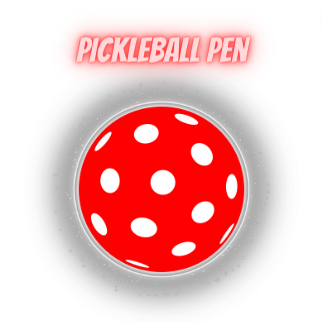What Is My Pickleball Rating? How to Identify Your Skill Level
Have you caught yourself wondering, “What is my pickleball rating? How do I improve it? What do those numbers even mean?” …Well don’t worry – I’ve put together a comprehensive guide that’ll tell you everything you need to know. You’ll walk away with the ability to give yourself a self-rating, and with clarity on how to improve your rating.
There are a few ways to determine your pickleball skill rating. I’ll take you through all the options so that you can take your pick…(leball!).
What Are Pickleball Ratings?
Your pickleball rating essentially ranks you against other players depending on your skill level. If you’ve been playing for longer, you’ll likely have a higher rating than someone who started a week ago, thanks to the various skills you’ve picked up along the way.
If you play for fun, self-rating is just fine. You can have a look at the criteria below, and rate yourself accordingly.
If you’re looking to play in a pickleball tournament, you need a less biased rating. I’ll take you through your options here too – there’s more than one official rating system.
Why Are Pickleball Ratings Important?
Ratings show your skill level compared to other players. If you play pickleball purely for fun, your rating isn’t super important. It’s casual, so only you and your opponent need to agree that you’re happy to play against each other.
Many players prefer playing against opponents with a similar pickleball skill rating. The rating naturally groups people of the same or similar skillset, making games more fun and competitive.
If you’re playing against somebody who’s much higher ranked than you, it’s pretty much a given that they’ll win. So playing against somebody of a similar skillset gives you a higher chance of a fun, competitive game.
In pickleball tournaments, ratings are used to group people.
How Is My Rating Calculated?
So how is your rating calculated? The first is a self-rating system, which most casual players use.
The following methods are used for official ratings. An official rating is needed to play in pickleball tournaments.
1. USAPA Skills Ratings
USAPA is the United States of America Pickleball Association, now known solely as USA Pickleball. They created the Play Skill Ratings Definitions, giving players the ability to define their skillsets accordingly to a list of criteria. This is what you’ll use if you’re self-rating. The rating is presented as two digits.
Here are the criteria per rating:
- 1.0 – 2.0: The player is just starting to play, and has no background playing any other sport.
- 2.5: The player has limited experience playing pickleball or a similar sport, and can sustain a short rally.
- 3.0: The player has some experience playing pickleball, and has an understanding of the fundamentals of the game as well as court positioning.
- 3.5: The player can acknowledge the difference between a soft game and a hard game. They understand when stacking may be effective, and can move quickly to the non-valley zone.
- 4.0: The player is able to identify and attack their opponent’s weaknesses. They’re able to stay aware of their partner’s position on the court and can therefore move as a team. If you’re playing singles, you’re able to keep track of the opposition well on the court.
- 4.5: The player understands the strategy that goes into the game and has good footwork. When playing doubles, they can communicate well with their partner and move as a team.
- 5.0: The player has mastered all pickleball strategies. Their footwork is efficient and they can easily adjust their strategy according to their opponent’s strengths and weaknesses. They don’t often make mistakes.
- 5.5: The player has mastered pickleball. They’re a top-caliber player who’s hard to beat.
As you can see, it’s easy to look at this list and determine where you lie because of how specific it is.
What’s important is that you’re honest when rating yourself (something I struggle with at times!). Even if you’re an amateur pickleball player, it’s best to honestly present your skill level to opponents.
2. USA Pickleball Tournament Ratings
The USA Pickleball Tournament Player Ratings is the first of the official rating systems. It’s commonly known as the UTPR System, and is the official USA Pickleball rating for sanctioned tournament play.
Your UTPR rating can be either a 2 or 4-digit rating, with 4-digit ratings being the ones used for tournament-seeding purposes. The 2-digit rating is a rounded-down version of the 4-digit rating. This means that the longer 4-digit rating gives a bit more information about your skillset and playing level.
You can access both versions of your rating if you’re a member of USAPA. You’ll find it on their website, under your member profile.
The rating is calculated based on your previous streak of wins and losses, unlike the self-rating system. USAPA uses its approved software to calculate your rating. But which games are used? What if you lose a practice game?
No need to worry. Recreational and practice games don’t count toward your UTPR rating. Games need to be sanctioned tournament games and registered on the Pickleball Tournament website.
The biggest advantage of using this rating method is that it’s more accurate than self-rating. One of the downsides is that the score of a match doesn’t matter – only wins and losses are recorded. A game can be super close, but if you lose, this negatively affects your rating.
Another con is that your score isn’t “live.” It’s only updated once a week, and also may have some regional and age bias.
3. Dynamic Universal Pickleball Ratings
Dynamic Universal Pickleball Rating is better known as the DUPR rating system. This is a relatively new system developed in 2021 by Steve Kuhn. He’s the founder of Major League Pickleball.
This new rating system was the result of trying to get rid of biased ratings. It aims to bring a global rating system to the sport, so there’s greater consistency in the pickleball skill level ratings.
There’s been some disillusionment and frustration expressed about the UTPR rating system among players, and this new rating system aims to fix its shortcomings.
The biggest problem with the UTPR rating system was that the algorithm gives each player a rating based only on results. It doesn’t take into account event type, location, or software provider.
The DUPR rating system takes into account more than whether you won or lost a game. It’s continually updated according to how well you performed in relation to expectations. The following criteria are factored into your rating:
- Did you win?
- How many points did you score?
- What type of match was it? (recreational game, tournament match, or league match?)
You’ll notice that one of the big differences here is that recreational matches are taken into account, as well as how many points you scored.
This ensures your rating reflects your overall abilities, not only your previous performance at pickleball tournaments.
You’ll likely be hearing more and more about the DUPR system in the coming years as people have started favoring its representation of skill levels. It’ll likely be used for global pickleball skill ratings in the future.

Classifying Your Skill Level
Over and above your self or professional ratings, you might want to categorize your pickleball skills.
Whether you only play recreationally or have achieved moderate success in the sport, it’s great to know whether you’re a beginner, intermediate player, or advanced player.
Beginner
A beginner is a player who’s never played pickleball before, or has maybe only played a couple times. They don’t have any other sports background.
They don’t know much about court positions or have any specific skills. They don’t know how to keep score yet and rely on others to help them through a game.
If you fall into this category, the good news is it only goes up from here! As you learn, you’ll start to feel more confident on the court and fall in love with the game the way we have.
Before you know it, you’ll have efficient footwork and know how to make some power shots.
Intermediate
Most players fall into the intermediate player bucket. These players generally have some skills, and may even be able to hit tricky shots like an erne.
Most players like playing against other players on the same scale as them, so they’ll often prefer to practice with other Intermediates, but that doesn’t mean they aren’t willing to challenge themselves as well!
Advanced
Advanced players are generally involved in some sort of league play. They can bang the ball hard, read their opponent’s strengths, have good mobility, and make no unforced errors.
They’re effectively direct in their play, and know when it’s best to take some soft shots and medium-paced shots.
Pickleball Skill Rating
These ratings or skill level distinctions are mostly used at local community centers and hold no official value.
They’re quite inconsistent – for example an advanced player at one center might be an intermediate player at another. The important thing is that you continuously try to improve and hone your skills!
You’re now armed with everything you need to give yourself a self-rating and can see what skills you need to acquire to improve that rating. If you want to play competitively in the future, obtain an official rating for yourself from one of the organizations mentioned above. And remember to always have fun!

